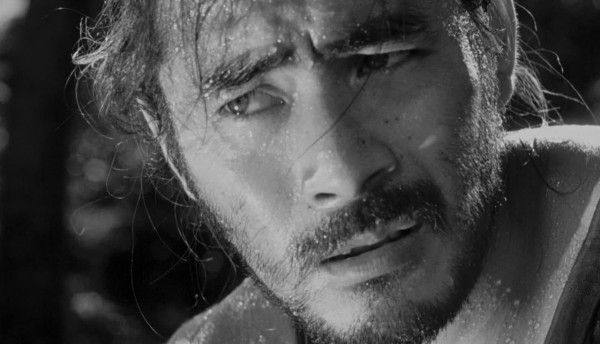
Exactly 95 years ago, on April 1, 1920, the Japanese actor Toshirō Mifune (1920-1997) was born in Qingdao, China. His parents were Christian missionaries working on the continent, and as a result Mifune spent his childhood in Japanese controlled China, growing up in Dalian and spending his formative years in Manchuria.
Today, Mifune is remembered as Japan’s most famous actor and his name and face are fundamentally associated with Akira Kurosawa. The two men worked together for two decades, producing a body a work which is typically considered among the greatest actor-director pairings in the history of cinema.
Yet, Mifune was not supposed to be an actor. His father owned a photography shop and the son was in fact looking to follow in his footsteps. Mifune served as an aerial photographer in World War II and later applied for a cameraman’s position at Toho Studios after the war. No such positions were available however, so in June 1946 Mifune ended up trying for the studio’s new faces programme, which was set up to attract new acting talent. Without any background in acting, Mifune’s audition didn’t go that well, but by chance he attracted Kurosawa’s interest. The young director spoke passionately on Mifune’s behalf and he was ultimately taken in. The rest, as they say, is history.
Mifune’s first appearance for Kurosawa was in Drunken Angel (1948), a film where he was supposed to play a supporting role next to Takashi Shimura but ended up hoarding much of the focus with his energetic performance. It was not the first time, however, that Mifune and Kurosawa were credited on the same film, for Mifune’s screen debut took place in the 1947 film Snow Trail that Kurosawa had written for Senkichi Taniguchi. During his career, Mifune appeared in seven other films that Kurosawa penned for other directors, in addition to starring in 16 films which Kurosawa directed. The two men also worked together on The Legacy of the 500,000 (1963), the only film directed by Mifune himself and for which Kurosawa agreed to do the editing.
The paths of the two men so suddenly and irrevocably diverged after Red Beard (1965). Why this happened has been subject to much speculation. Some have suggested that Mifune had grown unhappy with Red Beard‘s long shooting period which prevented him from taking other work and put his own production company into debt, while others have pointed to some parties having been unsatisfied with Mifune’s performance in the film and planted that seed of doubt also in Kurosawa. Kurosawa’s attempt to work with Hollywood after Red Beard must also have distanced the two men, and certain things were definitely said during Kurosawa’s failed Tora! Tora! Tora! production in the late 1960s which could have caused a rift, as Mifune was vocally unhappy that Kurosawa had decided to cast primarily amateur actors on such an important American financed film. Although the two men never worked together again and reportedly largely avoided each other’s company, towards the end of their careers each talked about their creative relationship in highly positive terms. In the end, Mifune and Kurosawa did reportedly reconcile their personal relationship in the early 1990s.
Although Kurosawa was instrumental in launching and nurturing Mifune’s career, the actor had a very successful career also outside of the director’s films, appearing in altogether close to 200 films. Early on in his career Mifune was typically cast in gangster roles, while later he crafted a successful and influential approach to samurai roles, highly influencing the genre in the process. Mifune was also in demand outside of Japan, appearing in numerous Hollywood films, including Steven Spielberg‘s 1941 (1979), John Frankenheimer‘s Grand Prix (1966), John Boorman‘s Hell in the Pacific (1968) and, perhaps most famously, the Shogun television series in 1980.
Mifune’s health began to deteriorate in the early 1990s, the cause of which has remained unknown to public. His condition worsened further when he was diagnosed with pancreatic cancer in 1995, and the by now already reclusive former actor disappeared from the public eye. Mifune died of multiple organ failure on Christmas eve, December 24, 1997, less than a year before Kurosawa passed away.
Today, Mifune would be 95 years old. How are you celebrating the great actor’s birthday?







I would have watched Drunken Angel if I had a copy of it, but I don’t. Instead, I started Throne of Blood. It was after midnight here, but it was still April 1st in other parts of the US at the time.
I’d only heard that Kurosawa and Mifune made things up in the early 90s recently, probably via this site. I am someone who thinks Mifune did worthy work outside of his association with Kurosawa, including his work on Shogun, which is the only non-Kurosawa work I’ve seen him in. It’s ironic, though; as much as I like and admire Mifune, I think others — Tatsuya Nakadai, for example — were capable of far more breadth and in that respect were better actors than Mifune. But Mifune was so charismatic and dynamic and so good (and consistent) at what he did well that he far surpassed them in fame.